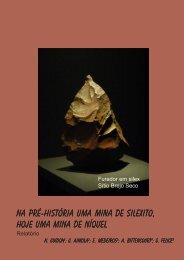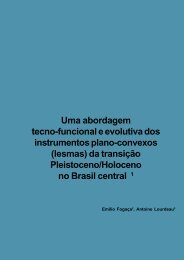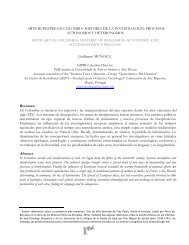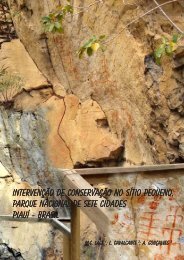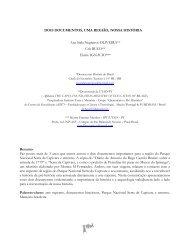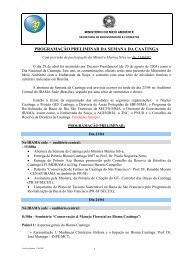Untitled - Fundação Museu do Homem Americano
Untitled - Fundação Museu do Homem Americano
Untitled - Fundação Museu do Homem Americano
You also want an ePaper? Increase the reach of your titles
YUMPU automatically turns print PDFs into web optimized ePapers that Google loves.
Global Rock Art Congress<br />
29 Junho – 3 de Julho 2009<br />
Gravadas e Esculpidas na Pedra: A Arte Móvel <strong>do</strong> IV Milénio A.C. Em Sesimbra (Portugal)<br />
Manuel Cala<strong>do</strong>, Luis Gonçalves & Leonor Rocha , Portugal<br />
As placas de xisto gravadas constituem um elemento maior no contexto das manifestações artísticas<br />
<strong>do</strong> neolítico final alentejano.<br />
Com base na presença maciça destes artefactos simbólicos no território de Sesimbra, onde a arte<br />
rupestre está, por ora, totalmente ausente, e o megalitismo é praticamente desconheci<strong>do</strong>, pretendem-se<br />
avaliar, numa perspectiva regional alargada, as relações de complementaridade ou de exclusão destes<br />
diferentes tipos de manifestações rituais. Nessa equação, entram elementos estruturantes, como são as<br />
diferenças paisagísticas e os nexos históricos diferencia<strong>do</strong>s. Em Sesimbra, a vida ritual parece organizarse<br />
em torno das riquíssimas paisagens cársicas, em cujas grutas foram depositadas as placas de xisto.<br />
Estas, por outro la<strong>do</strong>, parecem ter si<strong>do</strong> “fabricadas” num contexto em que a arte rupestre é um tema<br />
muito relevante, nas proximidades <strong>do</strong> grande complexo <strong>do</strong> Alqueva. No Alentejo, em contrapartida, arte<br />
rupestre e megalitismo ocupam territórios muito distintos: os xistos e os granitos, respectivamente; aí,<br />
as placas de xisto parecem estabelecer a ponte entre ambos.<br />
Plains Indian Cosmologies: Tentative Sources for Interpreting European Palaeolithic Cave Art<br />
Enrico Comba, Itália<br />
Traditional Plains Indian cosmologies describe a multi-layered world-view in which humans live in middle<br />
place. The world above is the abode of the heavenly bodies and other powers related with the sky, while<br />
the world below is conceived as the body of Mother or Grandmother Earth. Both humans and the other<br />
animals were believed to come from the interior of the earth, from the underground world. The spirits of<br />
the animals still are conceived of as living under the earth, in caves which open in the mountainside: from<br />
there they come out to be reborn and there they return after being killed by the human hunters. There<br />
is reason to suppose that the main elements of this world-view had their origin during the Palaeo-Indian<br />
period and have been transmitted to the bison-hunting cultures survived until the end of the XIXth century.<br />
The suggestion proposed here is to try to read the painted caves of Palaeolithic Europe in the light of this<br />
ancient cosmological system, which, possibly, was brought in the Americas by the first hunter-gatherers<br />
who peopled the continent.<br />
55<br />
Experience of Palaeoart Popularization<br />
Arsen Faradzhev, Rússia<br />
I’ll share in my report experiences on Palaeoart popularization, which include several approaches:<br />
Lectures for students, which took place at Moscow State University; Presentation for kids, which took<br />
place in State Darwin <strong>Museu</strong>m in Moscow;<br />
A radio interview, that was broadcast all over the Russian Federation, (12 time zones!);<br />
Publication of “Palaeoart chronicles”, in the most fashionable Moscow magazine “Art Chronicles”.<br />
El triunfo de la culebra. La imagen de la serpiente en el arte rupestre del Choapa.<br />
Diego Artigas, Chile<br />
Las distintas culturas han da<strong>do</strong> a la serpiente distintos valores, desde sabia consejera, hasta venenosa<br />
trai<strong>do</strong>ra, permanecien<strong>do</strong> en las narraciones desde el principio de los tiempos.<br />
En el norte semiári<strong>do</strong> y la zona central de Chile, la imagen maligna de la culebra es central en el<br />
universo simbólico campesino, y a primera vista parece ser una herencia cristiana. no obstante ellos, es<br />
necesario detenerse y profundizar en el verdadero origen de esta relación, que resulta ser mucho más<br />
propia del imaginario indígena antes que europeo. Bajo la hipótesis de que en las narraciones actuales<br />
se mantienen algunos elementos del relato mítico indígena original que dio forma a la manifestación<br />
rupestre, el análisis de algunos mitos y leyendas que tienen al personaje ofidio como eje central, permite<br />
observar la importancia simbólica de estos elementos en el arte de las comunidades prehispánicas.<br />
El arte rupestre de la zona del Choapa, con una enorme presencia de figuras serpentiformes, parece<br />
convertirse, entonces, en un medio esencial para<br />
Parque Nacional Serra da Capivara<br />
Piauí, Brasil




